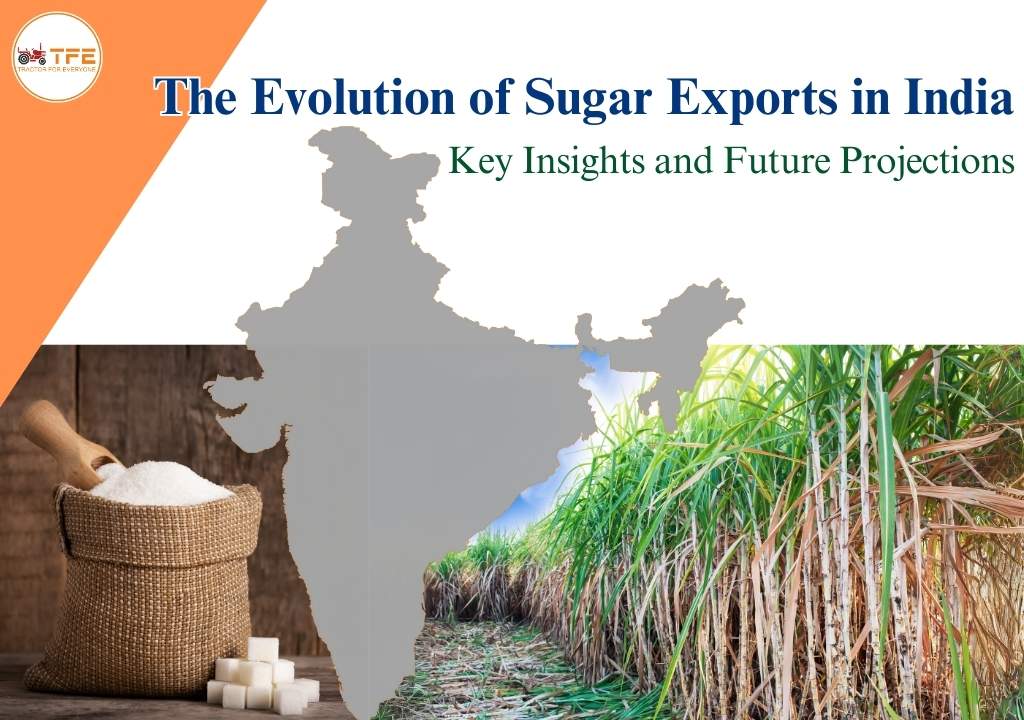Best Used Car, Services, Auto Parts, Rent Car Available for Buy and Sell Near By Go Ahead
- Swaraj Price 2025: Latest Swaraj Tractor Price List and On-Road Rates in India
- महिंद्रा मिनी ट्रैक्टर - कीमत, मॉडल, और सुविधाएँ
- Best Tractors in India 2025: Top 10 Picks for Every Farm Size
- Swaraj 855 FE Tractor Review 2025 Features, Price and Performance Explained
- महाराष्ट्र फार्मर आयडी: ऑनलाइन नोंदणी प्रक्रिया, कागदपत्रे आणि फायदे
- Sonalika Tractor Price 2025 Complete List of Models, Series and Latest Offers
- Swaraj Tractor Price List 2025: Best Tractors for Small, Medium & Large Farms
- Swaraj 744 FE Price, Features & On-Road Cost Explained for 2025
- Mahindra Tractors Price 2025: Complete List, Series-Wise Comparison and Best Models
- New Holland 3630 TX Super Plus+ Tractor Review 2025: Features, Price and Performance

The Evolution of Sugar Exports in India: Key Insights and Future Projections
India, known for its rich agriculture and farming traditions, has made a strong mark in the world’s sugar market. Today, in 2025, India stands as one of the largest sugar exporters globally, after decades of hard work by our farmers and the growth of modern technology in agriculture. According to recent reports, India exported around 6 million tonnes of sugar last season, making a big contribution to the world supply. The sugar industry in India not only supports millions of farmers but also plays an important role in the economy. With government support and new farming methods, sugarcane farming in India has become smarter and more sustainable. In this blog, we will take a closer look at the journey of sugar exports of India, the latest agriculture news, and what the future holds for Indian farmers and the sugar industry.
Sugar Exports of India: A Complete Overview
India’s sugar exports have played a crucial role in the global sugar market. Over the years, the country's position as a key exporter has evolved, shaped by both domestic and international factors. In this blog, we will look at the journey of India's sugar exports, current trends, challenges, and the expected future path.
Sugarcane and Its Role in India’s Agriculture
Sugarcane is one of the most important crops in India, covering millions of hectares across states like Maharashtra, Uttar Pradesh, and Karnataka. It supports the livelihood of over 50 million farmers and workers. With India being the second-largest sugar producer in the world, sugar exports have become an essential part of the country’s agricultural economy. The government’s focus on sugar production, ethanol, and water management has shaped India’s approach to sugar exports.
Past: India’s Emergence as a Sugar Exporter
Historically, India was a sugar importer. However, by the late 2000s and early 2010s, the country turned into a sugar exporter. Major bumper harvests in the years 2017–2019 led to surpluses, and the government introduced export subsidies to manage these stocks. This helped India penetrate markets like Indonesia, Bangladesh, and the UAE. At the same time, the Ethanol Blending Program began in 2018, encouraging sugar mills to divert some of the sugarcane towards ethanol production, ensuring a more sustainable balance between sugar and ethanol output.
Present: Export Restrictions and Shift Toward Ethanol (2023-2025)
In recent years, India has faced challenges due to climatic conditions like weak monsoons and droughts in key sugarcane-producing regions, leading to lower production. As a result, the government imposed export restrictions in 2023 and 2024, allowing only limited exports. For instance, only 6 million tonnes of sugar were allowed for export in 2023.
Global sugar prices also rose sharply due to supply shortages in other major sugar-producing countries like Brazil and Thailand. Despite these favorable price conditions, India prioritized domestic needs, focusing on ensuring that there was enough sugar available for local consumption.
One of the key trends in the present is the growing importance of ethanol production. The Indian government has set an ambitious target of 20% ethanol blending in petrol by 2025, which means more sugarcane will be diverted to ethanol production rather than sugar exports.
Future: Sustainability and New Markets for Sugar Exports (Post-2025)
Looking ahead, India’s sugar exports will continue to evolve, especially with the focus on ethanol. As the country works towards achieving the 20% ethanol blending target, the volume of sugar available for export is expected to decrease. The government will likely continue to balance domestic demand, ethanol production, and sugar exports carefully to avoid inflation and ensure food security.
Sustainability will play a crucial role in the future. With climate change affecting the sugarcane industry, water management and the adoption of sustainable farming practices like drip irrigation will become essential to maintaining productivity. Moreover, India is expected to explore new export destinations in Africa and Southeast Asia to keep its sugar exports profitable.
Another possibility for the future is the growth of premium sugar varieties like organic sugar and raw sugar, which are in higher demand globally. These products could fetch better prices, helping the industry thrive despite export limitations.
Government Policies and Initiatives for Sugar Exports
The Indian government has always played a significant role in shaping the sugar export industry. Key policies include:
- Fair and Remunerative Price (FRP): Ensuring a minimum price for sugarcane, which protects farmers.
- Ethanol Blending Program (EBP): Aiming for 20% ethanol blending by 2025, which has encouraged ethanol production.
- Export Subsidies and Restrictions: The government has periodically provided subsidies to boost exports, while also implementing restrictions when necessary to prioritize domestic supply.
Challenges Facing India’s Sugar Exports
While India has made significant progress in the sugar export market, several challenges persist. Climatic factors like erratic monsoons and droughts in sugarcane growing regions can significantly impact production. Additionally, international market volatility, influenced by countries like Brazil and Thailand, can affect global sugar prices.
Sustainability concerns related to the water-intensive nature of sugarcane farming also remain a key issue. With increasing water scarcity in regions like Maharashtra, the need for efficient water usage and climate-resilient farming techniques is crucial for long-term sustainability.
Summary:
In conclusion, India's journey in the sugar export market has been remarkable, with the country evolving from being a sugar importer to a major exporter. The past few years have been a testament to how India has adapted to global demands and challenges, particularly through government initiatives like export subsidies and the push for ethanol production. Today, as ethanol blending takes center stage, India is balancing its domestic needs with international demand for sugar.
Looking ahead, the road for sugar exports seems to be shaped by sustainability and innovation. With climate change affecting sugarcane farming and water resources becoming scarce, the focus will be on efficient farming practices. At the same time, exploring new markets and offering premium sugar varieties will be key to keeping India’s sugar export industry thriving.
As the world moves toward cleaner, greener alternatives like ethanol, India’s agricultural sector will need to remain agile and responsive to both domestic needs and global market trends. It’s an exciting time for the sugar export sector, and how India adapts to these changes will determine its success in the years to come.
In the end, it’s clear that the future of sugar exports in India will be a balancing act- ensuring enough sugar for domestic consumption while exploring new opportunities on the global stage. So, what do you think? Will ethanol production continue to dominate, or will sugar exports rise again as India’s primary agricultural export? The journey is far from over, and the choices made today will impact the direction for years to come.
Frequently Asked Questions (FAQ):
-
Why did India start exporting sugar in the first place?
Ans: India began exporting sugar due to its surplus production after becoming self-sufficient in the late 2000s. The government encouraged exports to manage the excess and help farmers and mills.
-
What are the main countries importing sugar from India?
Ans: India exports sugar mainly to countries like Indonesia, Bangladesh, UAE, Sudan, and Somalia, which are major importers of Indian sugar.
-
How does climate change affect India’s sugar exports?
Ans: Climate change impacts sugarcane farming, with irregular rainfall and droughts affecting crop yields. This can lead to lower sugar production and restrictions on exports to ensure domestic supply.
-
How does the government support the sugar industry in India?
Ans: The government provides subsidies for sugar exports, sets a minimum selling price for sugarcane, and promotes ethanol blending, which helps stabilize prices and supports the sugar industry.
-
What role does ethanol play in India’s sugar industry?
Ans: Ethanol production from sugarcane is becoming increasingly important as the government aims for 20% ethanol blending in petrol by 2025. This shift helps divert sugarcane from sugar production to ethanol, reducing pressure on sugar stockpiles.
-
How are water resources managed in sugarcane farming?
Ans: To address water scarcity, India is focusing on water conservation techniques like drip irrigation. Sustainable farming practices are becoming crucial for the future of sugarcane cultivation.
-
What are premium sugar varieties, and why are they important?
Ans: Premium sugar varieties, such as organic sugar and raw sugar, are in high demand in international markets. These types of sugar fetch better prices and are seen as a way for India to differentiate its sugar exports.
-
What challenges does the sugar industry face today?
Ans: The sugar industry faces challenges such as fluctuating global prices, climate-related issues, and the balancing act between domestic needs and export opportunities, especially during low production years.
-
Will India continue to limit sugar exports in the future?
Ans: Yes, India is likely to continue limiting sugar exports until domestic production stabilizes. The government will prioritize meeting local demand while balancing global export opportunities.
-
How will the sugar export market evolve in the coming years?
Ans: The market is expected to evolve towards sustainability, with more emphasis on ethanol production and water conservation in farming practices. Additionally, India will explore new export markets and diversify into premium sugar varieties.
-
 Post By Sharmila 30/08/2025
Post By Sharmila 30/08/2025The evolution of sugar exports is fascinating to read about.
Write a Comment
Popular Blogs View All
-

Swaraj Price 2025: Latest Swaraj Tractor Price List and On-Road Rates in India
07/24/2025, POSTED BY ADMIN -

महिंद्रा मिनी ट्रैक्टर - कीमत, मॉडल, और सुविधाएँ
02/18/2025, POSTED BY ADMIN -

Best Tractors in India 2025: Top 10 Picks for Every Farm Size
05/29/2025, POSTED BY ADMIN
Popular Video View All
-

महाराष्ट्रात Second Hand Tractors ची उत्तम संधी! तुमच्या बजेटमध्ये, विश्वासार्ह ट्रॅक्टर मिळवा!
12/16/2025, POSTED BY ADMIN -

TFE Reaper Machine Working | Full Multi-Crop Cutting Process!
12/16/2025, POSTED BY ADMIN -

5 Things You Need to Know Before Buying a Solis E Series Tractor
05/17/2025, POSTED BY ADMIN

